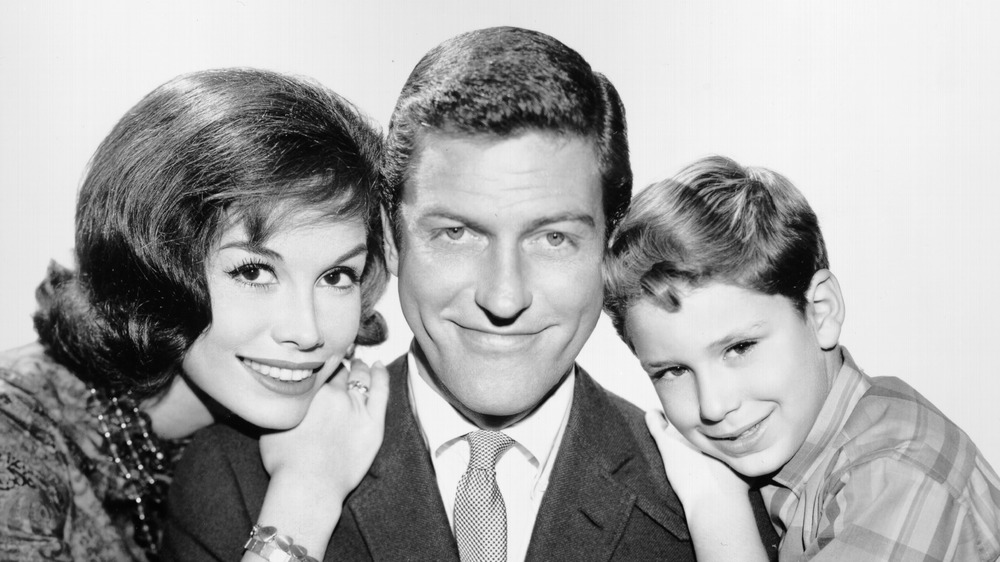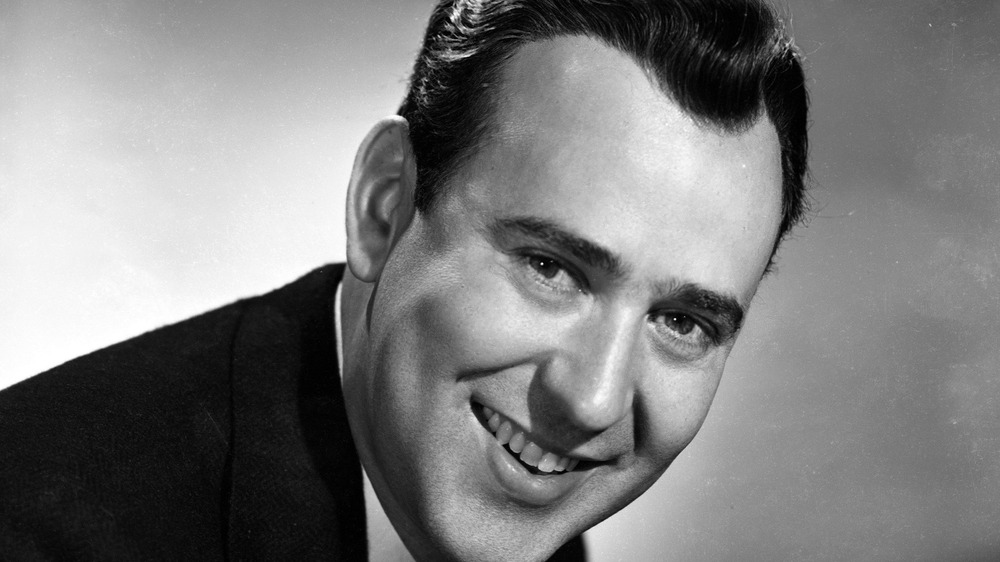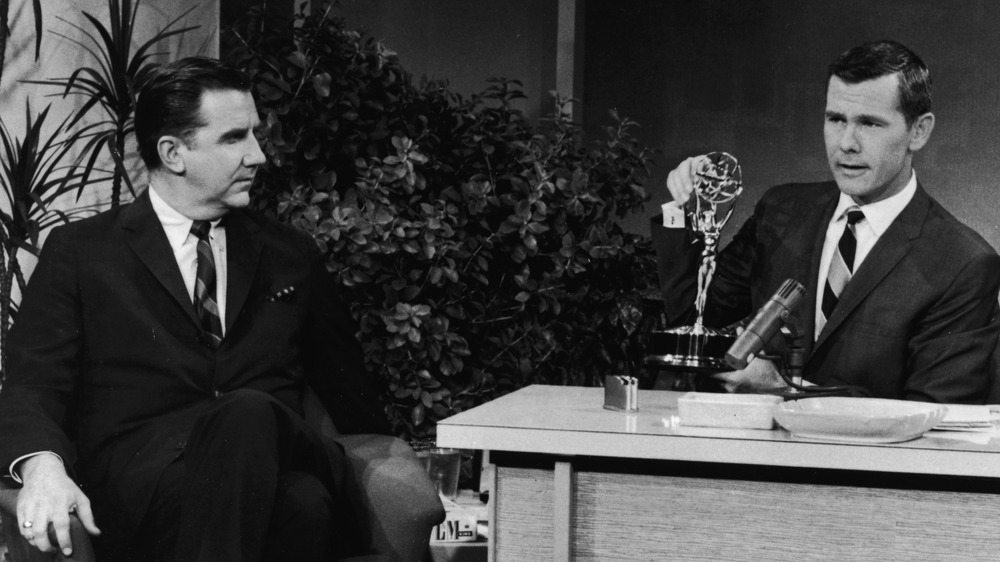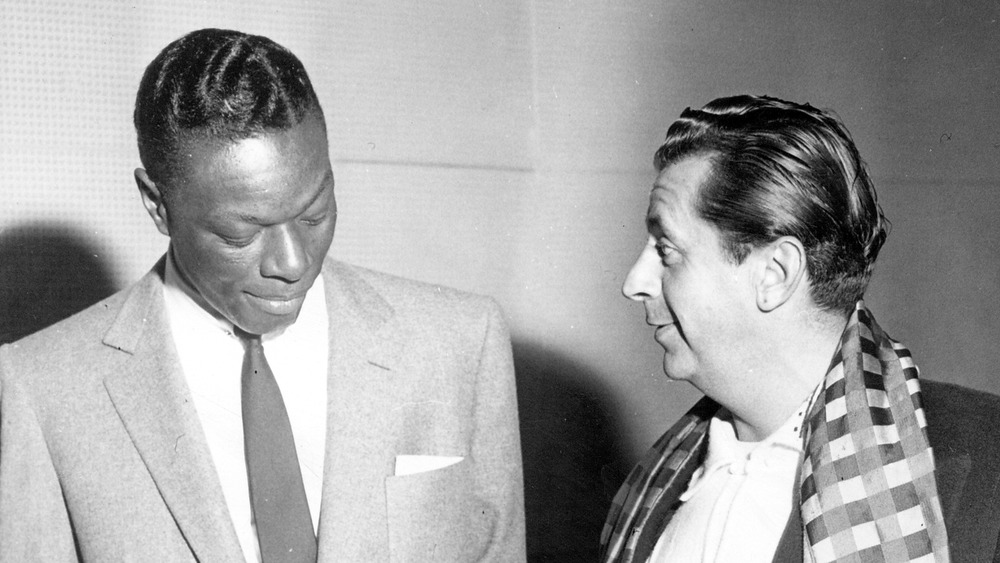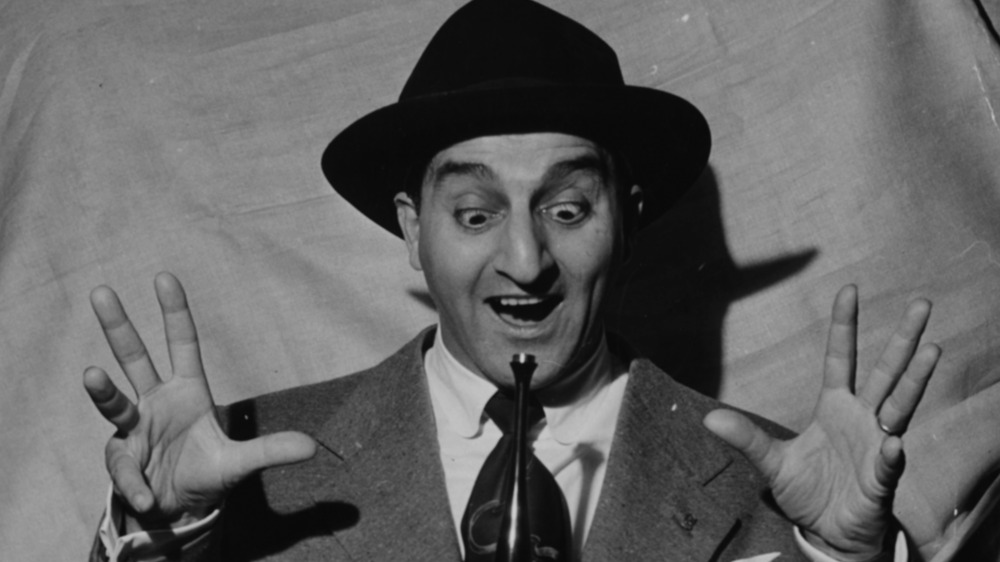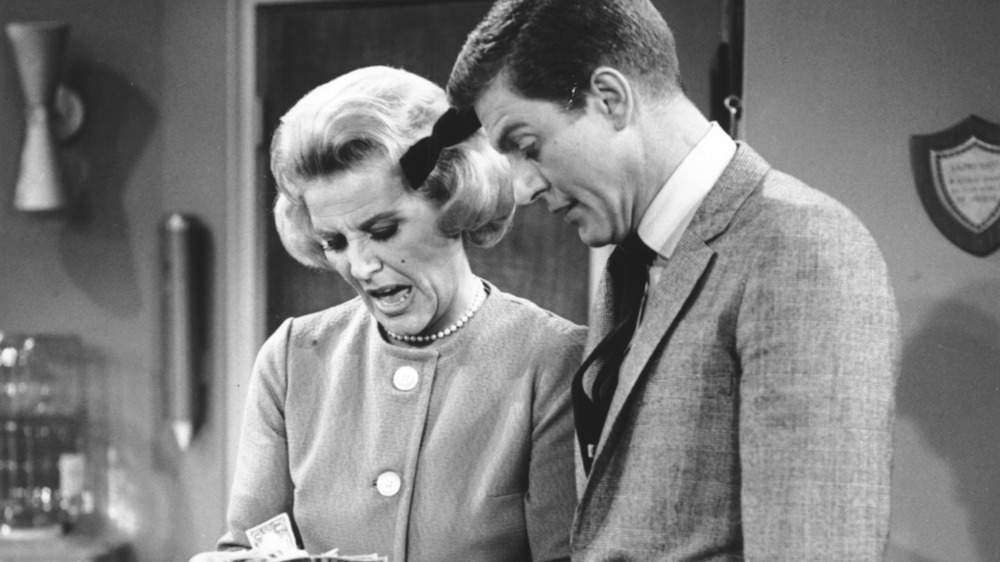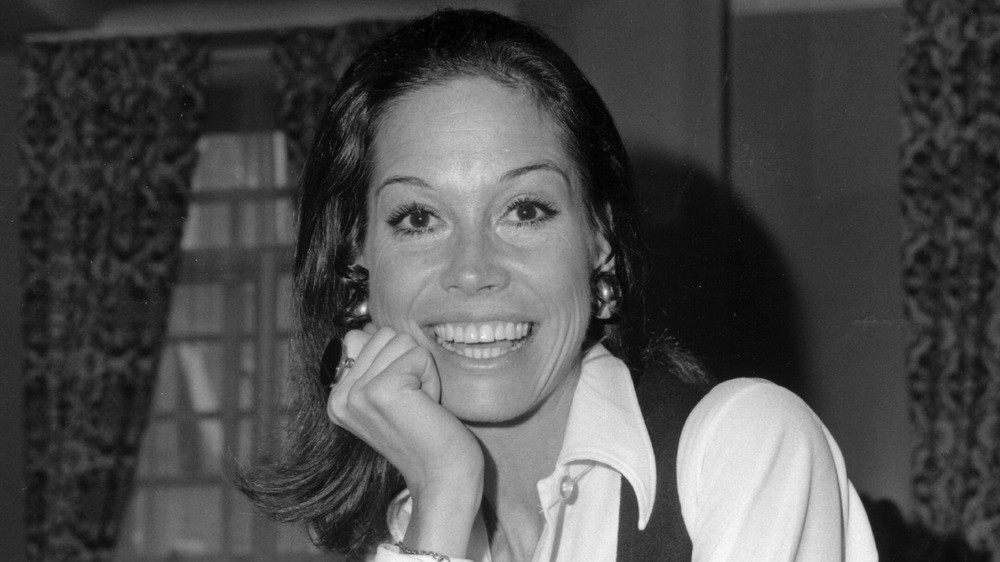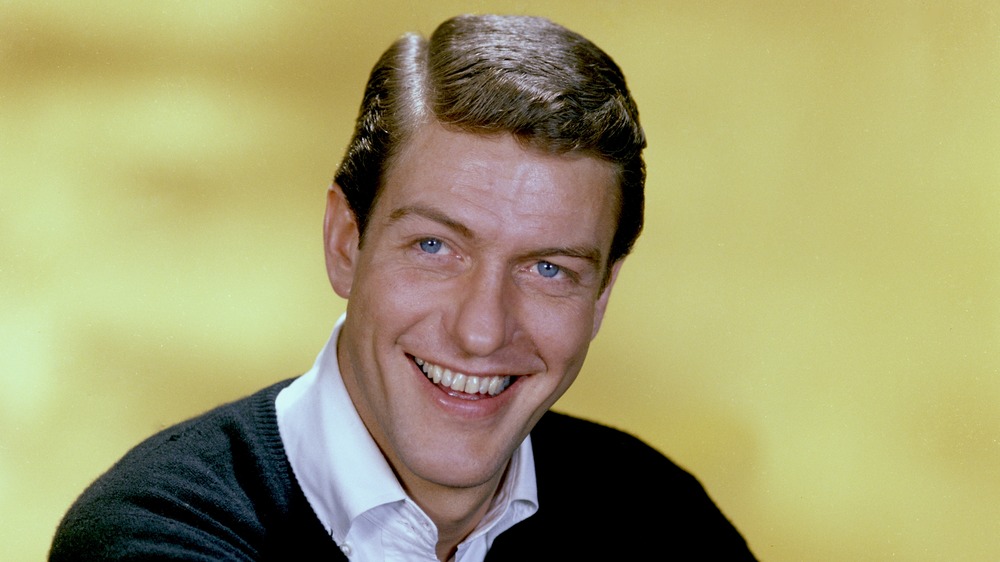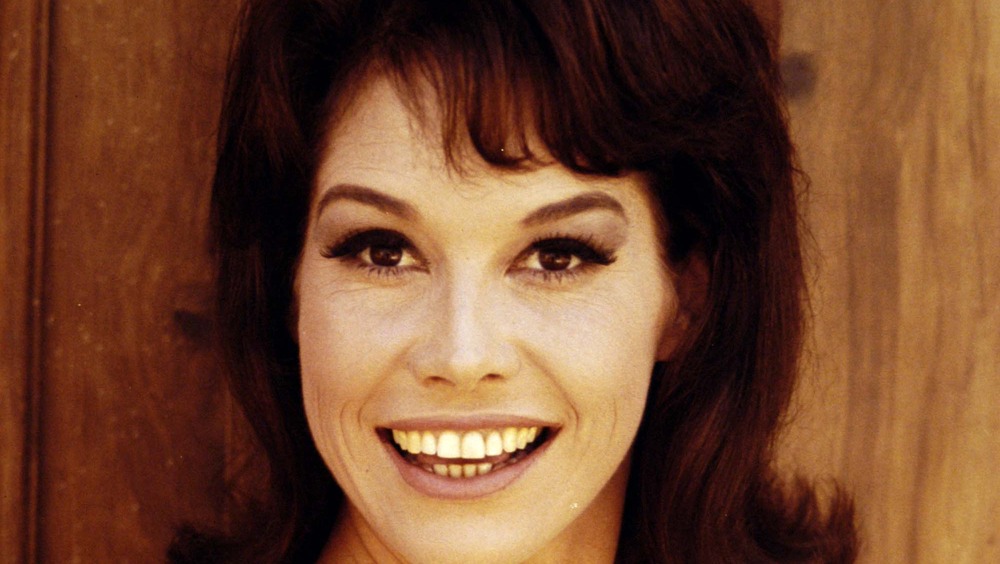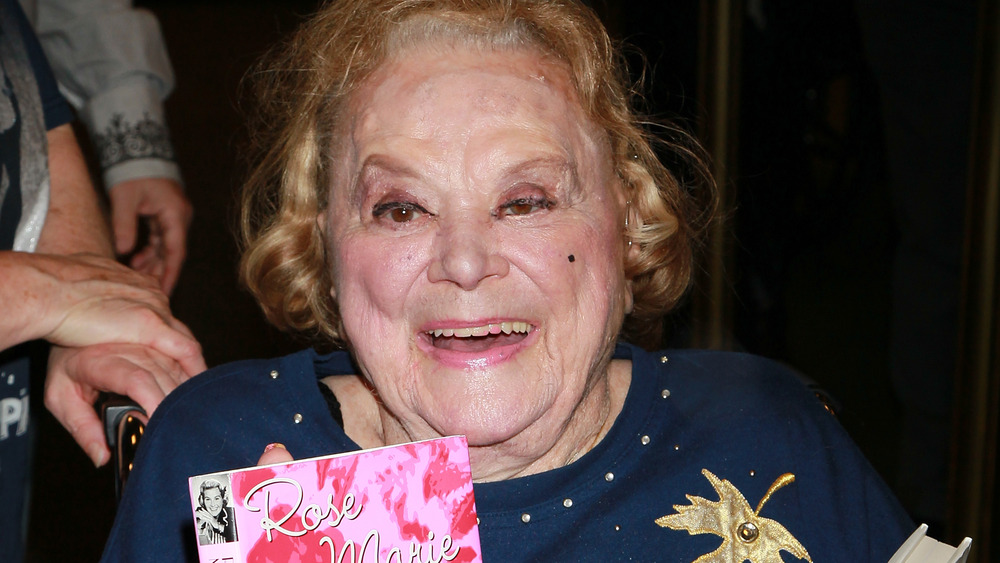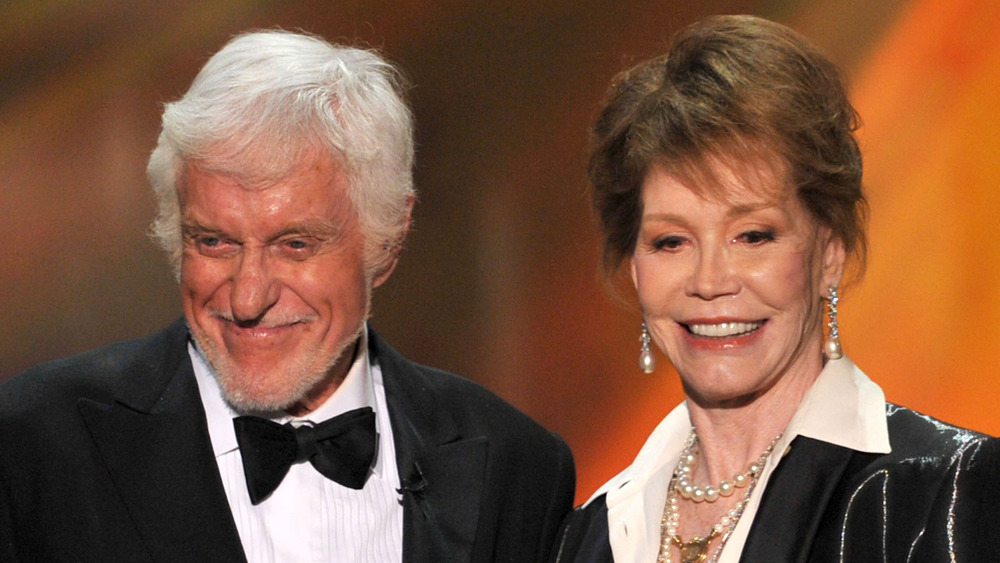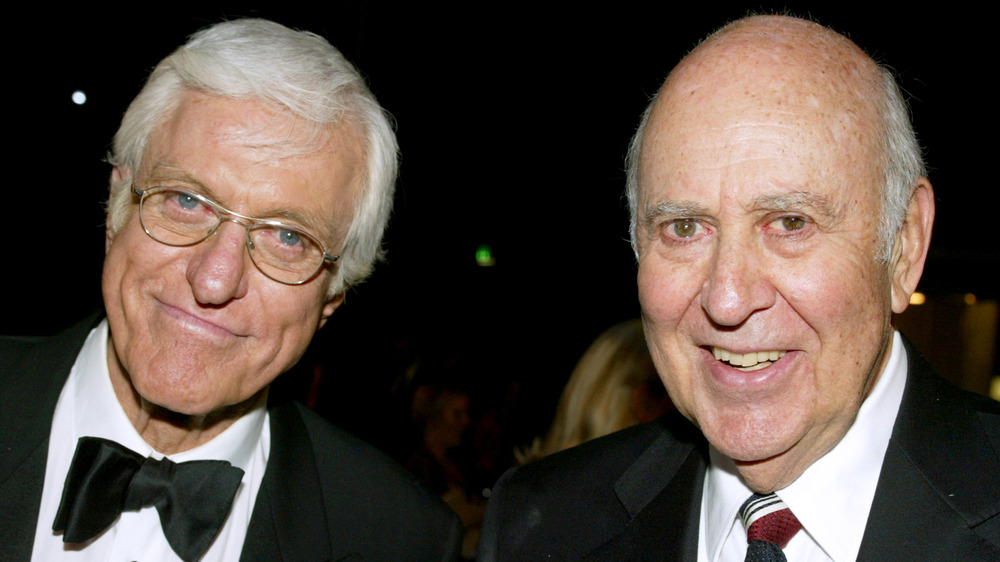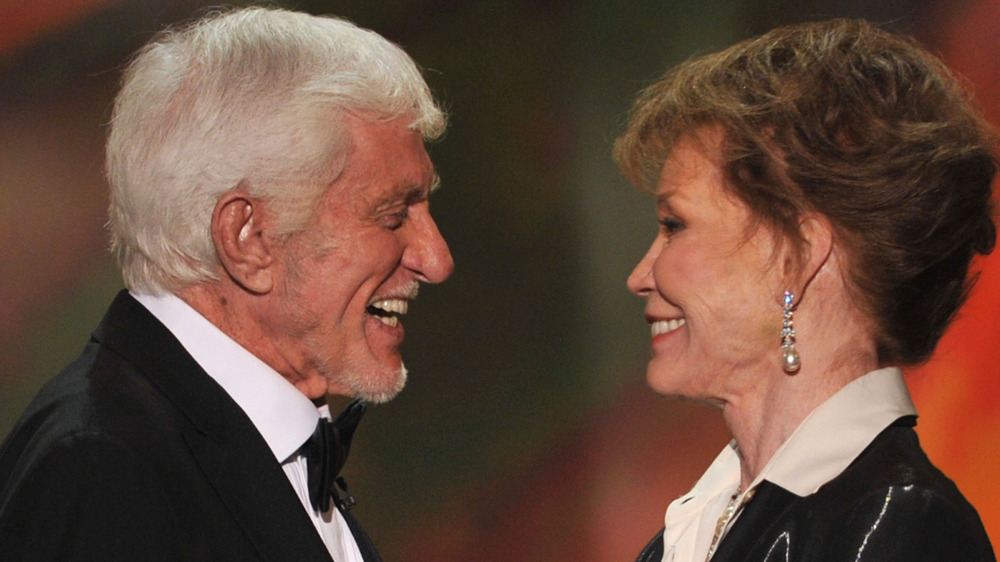The Untold Truth Of The Dick Van Dyke Show
The Dick Van Dyke Show, by the standards of today, appears to be one of the most innoffensive, most wholesome show of classic television. But the show was much more than that when it premiered in 1961. It was a show unlike anything viewers had ever seen before — it was witty, intelligent, comedically sharp, and quite ahead of its time socially. The network was at one point concerned about The Dick Van Dyke Show's appeal after low ratings after season one — which almost resulted in the show being yanked off the air. However, the show had garnered a passionate and vocal enough fan base that demanded the show's return and four additional seasons.
When The Dick Van Dyke Show finally ended in 1966, it left the airwaves on a high note. And the show made a lasting impression on the future of television sitcoms. Not only that, but it gave the world two major stars — Dick Van Dyke and Mary Tyler Moore — who both, thanks to the success of The Dick Van Dyke Show, went on to be respected and iconic Hollywood stars.
The Dick Van Dyke Show was Carl Reiner's idea
The Dick Van Dyke Show's origin actually didn't begin with Dick Van Dyke himself. It was originally the brainchild of Carl Reiner. According to Variety, Reiner was once a writer and performer on the NBC variety program, Your Show of Shows, and his experiences working on the program became the inspiration for the premise of The Dick Van Dyke Show. As noted by Parade, the name of the show was supposed to be called Head of the Family, and it would tell the story of TV writer Rob Petrie. The show would focus equally on Petrie's home life as a family man and his work life as a TV variety show writer. It was intended that Reiner would play the role of Rob Petrie.
Producer Sheldon Leonard loved Reiner's idea, but they were less enthusiastic about Reiner in the lead role and wanted to cast someone else. Even though Reiner wasn't the star, he still remained The Dick Van Dyke Show's head writer and creator, and he still played the memorable role of Petrie's boss, Alan Brady.
Johnny Carson was almost the show's lead
Although excited about Carl Reiner's sitcom idea, producers didn't feel confident about casting Reiner as the star — there is some heavy speculation that anti-Jewish bias may have been at the root of this decision. But the network decided a different Rob Petrie had to be found. Surprisingly enough, future Tonight Show host, Johnny Carson, was actually under serious consideration for the leading role. In fact, Carson was Dick Van Dyke's direct competition — according to Parade, Van Dyke and Carson were the last two finalists for the part of Rob Petrie.
In the end, Van Dyke won the role due to his significant name recognition coming off of a highly successful Broadway run of the musical Bye, Bye, Birdie. It can be assumed that Carson didn't have to feel very badly about losing the part as he managed to build an excellent and memorable career for himself in the future.
Morey Amsterdam wrote the theme song's lyrics
Everyone who knows The Dick Van Dyke Show remembers the opening theme song. And they naturally remember the theme's opening scene of Rob Petrie arriving home from work and comedically toppling over an ill-placed ottoman. However, most fans of the show would be very surprised to learn that the show's opening song did actually have lyrics. Much like The Andy Griffith Show, The Dick Van Dyke Show also has a memorable instrumental theme song that had unused lyrics. According to Parade, they were written by Dick Van Dyke's co-star, Morey Amsterdam, who played Buddy Sorrell. In a 2010 interview with NPR, Van Dyke revealed the actual lyrics, which had been a mystery for some time. In 2013, Van Dyke actually sang the full theme song for MeTV in a special music video.
Although Amsterdam's lyrics didn't end up being used, it's definitely one of classic television's most memorable opening theme songs.
Danny Thomas had a major role with the show
Danny Thomas was a major star and TV host in the 1950s and 1960s. He had his own hit show, The Danny Thomas Show, or Make Room For Daddy. Dick Van Dyke Show star Mary Tyler Moore actually auditioned to play Thomas' daughter on his show years earlier. Thomas liked Moore very much and thought she was definitely talented but didn't think she had quite the right look to play his daughter — he apparently said, "no one would believe a girl with a little button nose like hers could be a daughter of mine" (via Mental Floss).
But Thomas definitely remembered Moore years later, when he served as a producer for The Dick Van Dyke Show and personally recommended her for the part of Laura Petrie. Besides being a producer, Thomas also guest-starred on one of the show's most memorable episodes, "It May Look Like A Walnut." In this episode, Rob and Laura Petrie get spooked watching a science-fiction horror movie. Both have a nightmare starring Thomas as an evil alien leader trying to conquer the earth by turning humans into aliens with mysterious walnuts.
Rose Marie might have been the female lead
Everyone remembers Mary Tyler Moore's starring breakout role as Rob Petrie's wife, Laura. But the role of Laura Petrie was originally intended to be more of a side character. The real female lead was supposed to be Sally Rogers, Rob Petrie's co-worker on the Alan Brady Show and played by Rose Marie. And the part of Rogers was an excellent vehicle to display Marie's talent, a former child singing star who had been in show business for 30 years. The Dick Van Dyke Show was the perfect place for Marie to show off her comedic strengths, as well as her singing chops.
However, things changed when Moore was cast as Laura Petrie. Moore was young, vivacious, and charming — audiences loved her. Because of her popularity, more screen time was given to Moore rather than Marie. According to The San Diego Tribune, the increased focus on Moore did cause some conflict between Marie and Carl Reiner — the former being resentful that Moore was getting more attention from the show. Despite this, audiences still adored Marie's character. And as noted by The Los Angeles Times, Marie herself was always proud of her work on the show, as she said in an interview she gave to The Archive of American Television.
"The chemistry of that group is what made that show. It was a good show and cleverly done. It was brilliant. I enjoyed going to work every day. I didn't know it would be a classic."
The Dick Van Dyke Show was ahead of its time for women
For a television show created in the 1960s, The Dick Van Dyke Show was actually surprisingly progressive in how it portrayed women. For that particular time, at least. In the show, Rob Petrie's co-worker, Sally Rogers, was a professional working woman. Although she wasn't immune from female stereotypes of the time — serving as the office typist and portrayed as "man-hungry" — Sally Rogers was still shown as having a vital writing job beyond that of secretary.
Rose Marie herself was proud of the role and being able to play a character who wasn't "a wife, mother, or housekeeper," as noted by The Washington Post. During a reunion show in 2004, according to The Los Angeles Times, Marie recalled that Sally Rogers had a significant fan base. "I've had young girls come up to me and say, 'It was because of you I became a writer.'"
And even though she was playing a housewife, Mary Tyler Moore had her own ideas on how people should see Laura Petrie. Moore was determined to portray the housewife character realistically — Laura Petrie was not going to be a June Cleaver vacuuming the house in high heels and pearls. A young mother herself, Moore insisted that her housewife wardrobe needed to be comfortable and practical, eschewing fancy dresses in favor of capri pants and flat shoes. As noted by ThoughtCo, while Moore wasn't the first woman to wear pants on television, the image left an impact — capri pants soon became a highly popular clothing of choice for many women.
Dick Van Dyke struggled with alcoholism
Dick Van Dyke has always been an enthusiastic and passionate performer — and he certainly exuded these traits in his role as Rob Petrie. But behind the scenes, Van Dyke was harboring a dark secret. He was struggling with an addiction to alcohol. In a 2016 interview with Oprah Winfrey (via Entertainment Tonight), Van Dyke admitted that he was really quite shy and anxious with others, and alcohol was his only stress reliever. "I was very shy — with strangers — I couldn't talk to people. And I found if I had a drink, it would loosen me up. The barriers went down, and I became very social. That's what got me started."
According to Country Living, Van Dyke wouldn't actually seek help and check himself into rehab until 1972. His first wife, Margie Willett, also was suffering from an addiction to prescription drugs and sought help at the same hospital. Their marriage did not survive between their respective troubles and Van Dyke's hectic career, and they eventually separated — though they did not divorce until 1984.
Today, Van Dyke is much more open about his past struggles with alcoholism. He admitted that it was an incredibly long and difficult road for him to fully overcome his addiction. But he is proud that his story has helped and inspired so many other people.
"I get a lot of letters from people, who say all of a sudden they weren't ashamed to admit they had a drinking problem and they got help. So I'm very proud of that."
Mary Tyler Moore suffered from diabetes symptoms
While on The Dick Van Dyke Show set, behind Mary Tyler Moore's vivacious performance was the onset of severe future health problems. According to Mental Floss, Moore started having issues with dizziness, weight loss, and blurred vision. She thought her symptoms were due to stress and overwork, so she ignored her troubles, likely assuming that a break and relaxation would alleviate them. It wouldn't be until 1970, at the age of 33, that Moore would be diagnosed with Type I Diabetes, reports Healthline.
In an interview with MedlinePlus in 2006 (via Health), Moore said that she was absolutely stunned by the diagnosis. "I was, after all, a very healthy and active adult, and I didn't ever expect something like that to happen to me."
However, Moore didn't let diabetes prevent her from having a long and successful career. And in addition to acting, Moore became the face of diabetes advocacy and research, helping to raise millions of dollars for research funding. Diabetes was once considered a death sentence, but Moore was able to show that thanks to new technological developments and treatments, those diagnosed with the disease could have happy, normal, and fulfilling lives.
Rose Marie's husband passed away
Unlike her character, the perpetually single and man-hungry Sally Rogers, Rose Marie was happily married to Bobby Guy, a trumpet player who performed on NBC and in Kay Kyser's band. They had a daughter together, named Georgiana. However, while Marie was still on The Dick Van Dyke Show, Guy died of a mysterious blood disease in 1964 at the age of 48. He and Marie had been married for 18 years.
According to The Los Angeles Times, Marie was so devastated by the loss of her husband that she almost quit the show — she felt that she just couldn't go on. The show's director, John Rich, intervened and convinced her not to leave. Years later, Marie detailed in a book how kind and sympathetic everyone on the show was to her after her husband's death.
"Everybody was so marvelous. If there were things in the script they thought might upset me, they'd write it out. They were the best in the world. They were family."
The Dick Van Dyke Show was almost canceled prematurely
The Dick Van Dyke Show lasted for five years, but it was almost canceled for good after only one season. According to Forbes, the show was different than most sitcoms on the air at the time — witty, sophisticated, and a little controversial (i.e., Mary Tyler Moore's capri pants), so ratings remained on the low end after the first season ended (via Outsider).
CBS was ready to pull the plug on the show until advertiser Procter & Gamble intervened. The company's executives were huge fans of the show and threatened to yank all its advertising from the daytime lineup if CBS dared cancel Dick Van Dyke. CBS relented and instead gave the show a new time slot where the ratings got a massive boost.
The Dick Van Dyke Show thrived for five seasons, and it could have gone for multiple seasons longer had the cast agreed to it. However, everyone was in agreement that the show should end after season five while they were all at the height of their popularity. "Quit while you're ahead" seemed to be the general sentiment among the cast and crew.
The Dick Van Dyke Show did take a stance on race
The Dick Van Dyke Show was certainly not a racially diverse show — but in one episode, the show had a surprisingly unusual take on race. In the episode, Rob and Laura Petrie tell the story of when they first brought their son home from the hospital. Through a few misunderstandings, they become increasingly fearful that they brought home the wrong baby. The Petries reached out to the only other couple, the Peterses, who had a baby boy born at the hospital on the same day. When they meet the Peterses, it turns out the other family is African-American, relieving everyone's worries.
Today, people wouldn't consider this one minor appearance of a Black couple even meeting the bare minimum of trying to diversify a TV show. However, according to The New York Times, by 1960s standards, this was considered astonishing — almost downright mind-blowing. Here, viewers saw an ordinary, professional upper-middle-class Black couple — they weren't waiters, domestic help, or servants. Furthermore, no one on what was probably the tamest show of the time acted as though it was unheard of that a Black couple would be having a baby only a few doors down from a very white couple.
The story concludes with Rob and Laura Petrie stating that the two boys are now in school together — with the other son getting straight As and their own son decidedly mediocre. While a very minor portrayal of African-Americans in the grand scheme of things, it certainly was a jolt to white American viewers.
The show advanced the careers of Dick Van Dyke and Mary Tyler Moore
When The Dick Van Dyke show ended in 1966, the show exited the airwaves on a high note. And the show's leading actors, Dick Van Dyke and Mary Tyler Moore, were still incredibly popular. These two were destined for greater stardom. According to PBS, Van Dyke went on to star in the movie adaptation of Bye, Bye Birdie and reprise the role of Alfred Peterson that he originated in the original Broadway production. He would also go on to lead several other television shows and some well-known films, such as Mary Poppins, Chitty Chitty Bang Bang, and Dick Tracy.
And as for Moore, she went on to make several Hollywood movies and musicals before returning to the small screen. And this time, instead of playing a homemaker, she would be leading her own TV show as a single, independent, career woman on The Mary Tyler Moore Show. On The Dick Van Dyke Show, Moore had proven herself by holding her own with show business veterans like Van Dyke, Rose Marie, Morey Amsterdam, and Carl Reiner. She was more than capable of carrying her own show — and she knocked it out of the park. The Mary Tyler Moore Show lasted for seven seasons and has made its mark in the history of television. And The Dick Van Dyke Show can be attributed to the success of these historic and iconic pioneers of entertainment.
